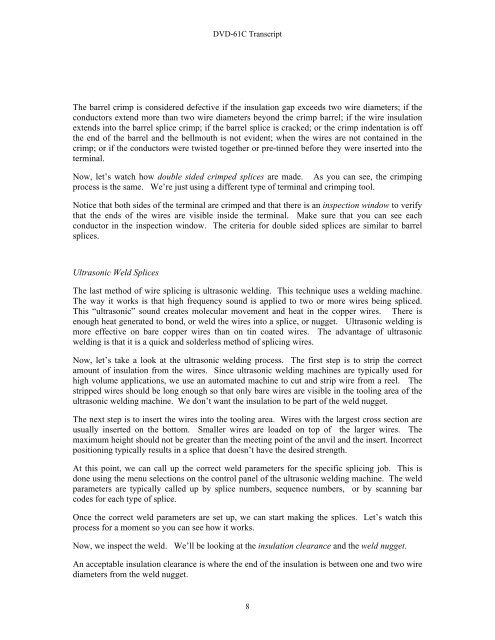DVD-61C Splicing Wires - IPC Training Home Page
DVD-61C Splicing Wires - IPC Training Home Page
DVD-61C Splicing Wires - IPC Training Home Page
Create successful ePaper yourself
Turn your PDF publications into a flip-book with our unique Google optimized e-Paper software.
<strong>DVD</strong>-<strong>61C</strong> TranscriptThe barrel crimp is considered defective if the insulation gap exceeds two wire diameters; if theconductors extend more than two wire diameters beyond the crimp barrel; if the wire insulationextends into the barrel splice crimp; if the barrel splice is cracked; or the crimp indentation is offthe end of the barrel and the bellmouth is not evident; when the wires are not contained in thecrimp; or if the conductors were twisted together or pre-tinned before they were inserted into theterminal.Now, let’s watch how double sided crimped splices are made. As you can see, the crimpingprocess is the same. We’re just using a different type of terminal and crimping tool.Notice that both sides of the terminal are crimped and that there is an inspection window to verifythat the ends of the wires are visible inside the terminal. Make sure that you can see eachconductor in the inspection window. The criteria for double sided splices are similar to barrelsplices.Ultrasonic Weld SplicesThe last method of wire splicing is ultrasonic welding. This technique uses a welding machine.The way it works is that high frequency sound is applied to two or more wires being spliced.This “ultrasonic” sound creates molecular movement and heat in the copper wires. There isenough heat generated to bond, or weld the wires into a splice, or nugget. Ultrasonic welding ismore effective on bare copper wires than on tin coated wires. The advantage of ultrasonicwelding is that it is a quick and solderless method of splicing wires.Now, let’s take a look at the ultrasonic welding process. The first step is to strip the correctamount of insulation from the wires. Since ultrasonic welding machines are typically used forhigh volume applications, we use an automated machine to cut and strip wire from a reel. Thestripped wires should be long enough so that only bare wires are visible in the tooling area of theultrasonic welding machine. We don’t want the insulation to be part of the weld nugget.The next step is to insert the wires into the tooling area. <strong>Wires</strong> with the largest cross section areusually inserted on the bottom. Smaller wires are loaded on top of the larger wires. Themaximum height should not be greater than the meeting point of the anvil and the insert. Incorrectpositioning typically results in a splice that doesn’t have the desired strength.At this point, we can call up the correct weld parameters for the specific splicing job. This isdone using the menu selections on the control panel of the ultrasonic welding machine. The weldparameters are typically called up by splice numbers, sequence numbers, or by scanning barcodes for each type of splice.Once the correct weld parameters are set up, we can start making the splices. Let’s watch thisprocess for a moment so you can see how it works.Now, we inspect the weld. We’ll be looking at the insulation clearance and the weld nugget.An acceptable insulation clearance is where the end of the insulation is between one and two wirediameters from the weld nugget.8
















